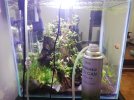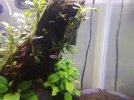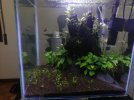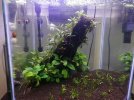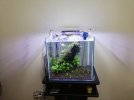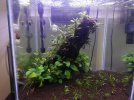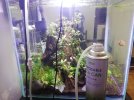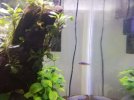Mraqualover
New Member
- Messages
- 10
Good evening, everyone. I know this forum is mainly for cichlids, but I need your help with a problem that has come up. I appreciate any assistance you can provide.
Information:I have two aquariums, both 60 liters: one cube-shaped and one rectangular. The rectangular tank has a JBL e702 filter, which is more than sufficient for the aquarium. In fact, I had to direct the filter output towards the glass because my latest addition (a Blue German Ram) didn't like the strong water movement. This tank is planted and houses four Leopard Danios, two Cherry Barbs, one Blue German Ram, and some shrimp.
The cube tank has a SLIM FILTER JINX 638-H hang-on-back filter. It contains various plants, including floating plants, and previously had eight Galaxy Rasboras (six added recently and two older ones), along with many shrimp.
Problem:Last night, all eight Galaxy Rasboras were present. However, this afternoon I found four of them dead, including the two older ones that had been well-acclimated for over three months.
Possible Causes:
Question:Does anyone have any idea what might be causing this issue and what I should do now that the damage is done?
Information:I have two aquariums, both 60 liters: one cube-shaped and one rectangular. The rectangular tank has a JBL e702 filter, which is more than sufficient for the aquarium. In fact, I had to direct the filter output towards the glass because my latest addition (a Blue German Ram) didn't like the strong water movement. This tank is planted and houses four Leopard Danios, two Cherry Barbs, one Blue German Ram, and some shrimp.
The cube tank has a SLIM FILTER JINX 638-H hang-on-back filter. It contains various plants, including floating plants, and previously had eight Galaxy Rasboras (six added recently and two older ones), along with many shrimp.
Problem:Last night, all eight Galaxy Rasboras were present. However, this afternoon I found four of them dead, including the two older ones that had been well-acclimated for over three months.
Possible Causes:
- Water Parameters: I tested the water and found 0 nitrites and 0 ammonia. However, when setting up this tank, I left some openings in the driftwood and between some stones that create pockets where water flow might be restricted. I'm unsure if these areas could have different parameters, but I doubt it would result in both ammonia and nitrites being at zero.
- Nitrate Levels: The nitrate levels in both tanks have been high, above 50 ppm. Normally, I use well water that has about 20 ppm of nitrates. This time, I decided to use treated tap water with a nitrate concentration below 10 ppm. I left the tap water in open containers on my balcony for two days to dissipate the chlorine. Yesterday was the first time I added tap water to the tanks. In the cube tank, I replaced about 10% of the water. I doubt this caused the issue since I replaced 50% in the rectangular tank with no fatalities.
- New Fish Quarantine: I did not quarantine the six new Galaxy Rasboras before adding them to the tank, so they might have brought a disease. However, it's strange that my two older fish died first before the newer ones and that four fish died within a day.
Question:Does anyone have any idea what might be causing this issue and what I should do now that the damage is done?

